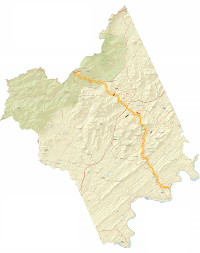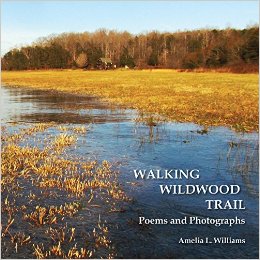by Mary Eiserman | Apr 15, 2024 | Outdoor Explorations
Getting the blues is not something many people think about in April when the
whole world is bursting with new life. However, spring is when some of nature’s
loveliest blues arrive.
Spring Azures are butterflies that appear in the earliest days of spring, from
Canada to Florida. Their Latin scientific name is Celastrina ladon, which can be
loosely translated as Heavenly Spirit. And indeed, watching these baby-blue waifs
flit gracefully along the ground – visiting both flowers and mud puddles – it is easy
to see how they were given such a lofty name.
Males can be distinguished from females by their lighter blue color. Females
come in a slightly darker blue, but the blue is only visible when they are flying.
Luckily for us, they fly so low to the ground that we normally see them while
looking down from above as they fly by. When they perch, they fold their wings
over their back and all you see is the whitish underside of the wing with a few
black spots.
Both sexes have big, black shiny eyes and long antennae with zebra black-and-
white stripes. Of course, these features can only be seen if you look at them
through a good pair of binoculars. After all, their wingspan is only an inch wide.
In keeping with their small size, they have a very short proboscis (tongue), so they
can’t reach nectar from very many species of flowers.
The Spring Azure has one of the shortest lifecycles of any butterfly. Adults only
live for two to five days, but since there are several generations, you can see
them from March through May. Once summer arrives, they are replaced by a
related species, the Summer Azure, which has a slightly longer lifespan.
Enjoy getting the blues in springtime!
by Susan McSwain for FoN
by Mary Eiserman | Apr 12, 2024 | Recycling
Panelists: AI has a bigger role to play in recycling (resource-recycling.com)
Goals include using AI to try to solve some of the main challenges of the recycling business, particularly when it comes to sorting materials.
Extended producer responsibility legislation and other laws can help, but it may be possible for AI capabilities to create automated sorting processes for increasingly niche types of materials. There are other ideas for streamlining the recycling process, such as assisting in maximizing the efficiency of chemical recycling.
by Mary Eiserman | Feb 19, 2024 | Outdoor Explorations
Just about everyone likes maple syrup. Most maple syrup sold in stores comes from Sugar Maple orchards in New England and Canada, but it is possible to make syrup from other species of maples … if you have the time and patience.
There are more than 100 species of maple trees that are native to Asia, Europe, Africa, and North America, but only 14 species have sap with a high enough sugar content to make syrup production a viable undertaking.
The sugar content of sap is highest in – you guessed it! – Sugar Maples. It takes 40 gallons of sap from a Sugar Maple to make 1 gallon of syrup. Depending on the species of the other maples that can be used for syrup production, up to 80 gallons of sap may be required to make 1 gallon of syrup. A healthy maple tree can produce between 5 to 15 gallons of sap in a season, depending on the size of the tree, its species, location, age, and the weather.
The Red Maple (Acer rubrum) is the most common tree not only in Virginia, but throughout most of the eastern U.S., and its sap can be used to make maple syrup. it is a very adaptable species, with the widest tolerance for varying soil conditions of any other tree native to North American forests. It is native to every county in Virginia from the coast to the mountains. Red Maples are not generally used for commercial syrup production because their sap season is shorter than other maples. If you drive around Nelson, you can see a few trees that have already started to bud out. Once budding occurs, sap collection must be discontinued. Squirrels eat the buds, birds eat the seeds, and deer browse new sprouts. They don’t need maple syrup to enjoy the flavor!
by Susan McSwain for FoN
by Mary Eiserman | Feb 2, 2024 | Clean Energy, Environmental Impact
New Jersey enacts EPR for EV batteries (resource-recycling.com)
New Jersey is the first state to make producers responsible for electric vehicle batteries and other, similar propulsion batteries. In three years, a ban on disposing of propulsion batteries in landfills [in N.J.] will come into effect. A consumer complaints and public education program is being established by the N.J. Department of Environmental Protection. Battery producers will be required to create and submit management plans to the state Department of Environmental Protection
Other states have used similar extended producer responsibility (EPR) bills to manage other kinds of batteries. Vermont did so in 2014 for single-use household batteries. In 2021, Washington D.C. enacted the U.S.’s first single-use and rechargeable battery EPR law, followed by California in 2022 and Washington state in 2023.
Banning EV batteries from landfills could help build the battery recycling industry.
by Mary Eiserman | Jan 17, 2024 | Outdoor Explorations
The natural beauty of Nelson is a major reason why people live here and visit here. Come journey with us as our nature series of articles sheds light on plants and animals that make Nelson County, Virginia such a special place.
Most people know that the Cardinal is the state bird of Virginia. It is found in much of the U.S. east of the Rockies, and it is easily identified by everyone. Since Cardinals do not migrate, they provide a splash of crimson among the grays and browns of winter. This makes them a colorful icon on Christmas cards.
One of the first known paintings depicting a Cardinal was done in 1599, and the bird was referred to as the “Virginia Nightingale.” Today, modern bird guidebooks use the name “Northern Cardinal.” Why northern? Because there is a different species of Cardinal in the southwestern U.S. and Mexico, with another species in Venezuela and Colombia.
In the mid-1700s, the Swedish botanist, Linnaeus, devised the system of taxonomy that uses Latin words (and sometimes Greek) as the scientific name assigned to every species. Want to impress your friends? Say this aloud twice: “Card-in-NAIL-is … card-in-NAIL-is.” All right! You have just pronounced this bird by its scientific name (Cardinalis cardinalis). It is really easy to say and to remember.
In 1926, Kentucky became the first state to choose the Cardinal as its state bird, calling it the “Kentucky Cardinal.” Between 1929 and 1949, four other states selected the Cardinal as their state birds – Illinois, Ohio, North Carolina, and West Virginia. In 1950, Virginia also chose the Cardinal as its state bird, and in 1963, Indiana became the seventh state to designate the Cardinal as its state bird. Of note, the most common state bird after the Cardinal is the Western Meadowlark, which has been chosen by six states.
Although male birds tend to be the singers in most species, about 12% of species in North America also feature female singers. The Cardinal is one such species. You can listen here to both a female and male singing: A Female Northern Cardinal Singing (and a male too) – YouTube
If you hear a pair of singing Cardinals, pause what you are doing and listen. It will brighten your day!
by Susan McSwain for FON






